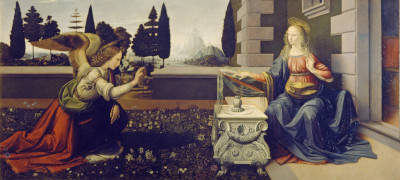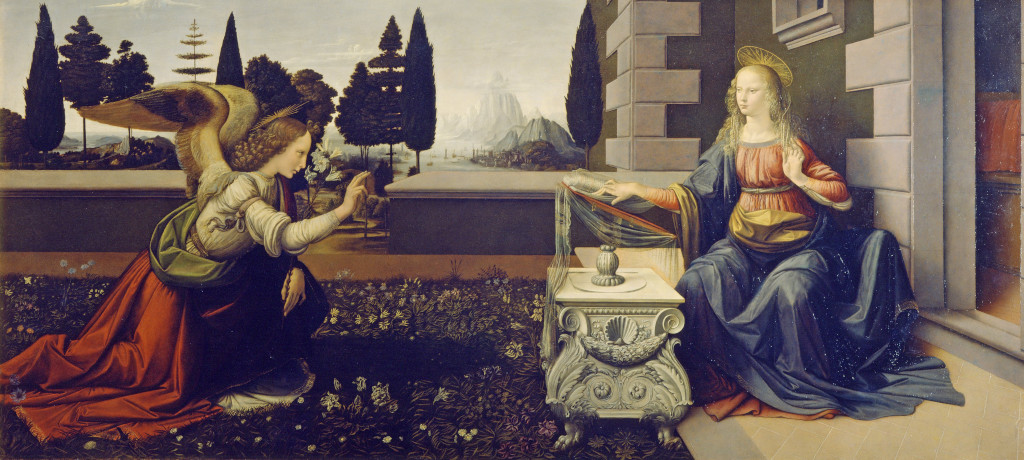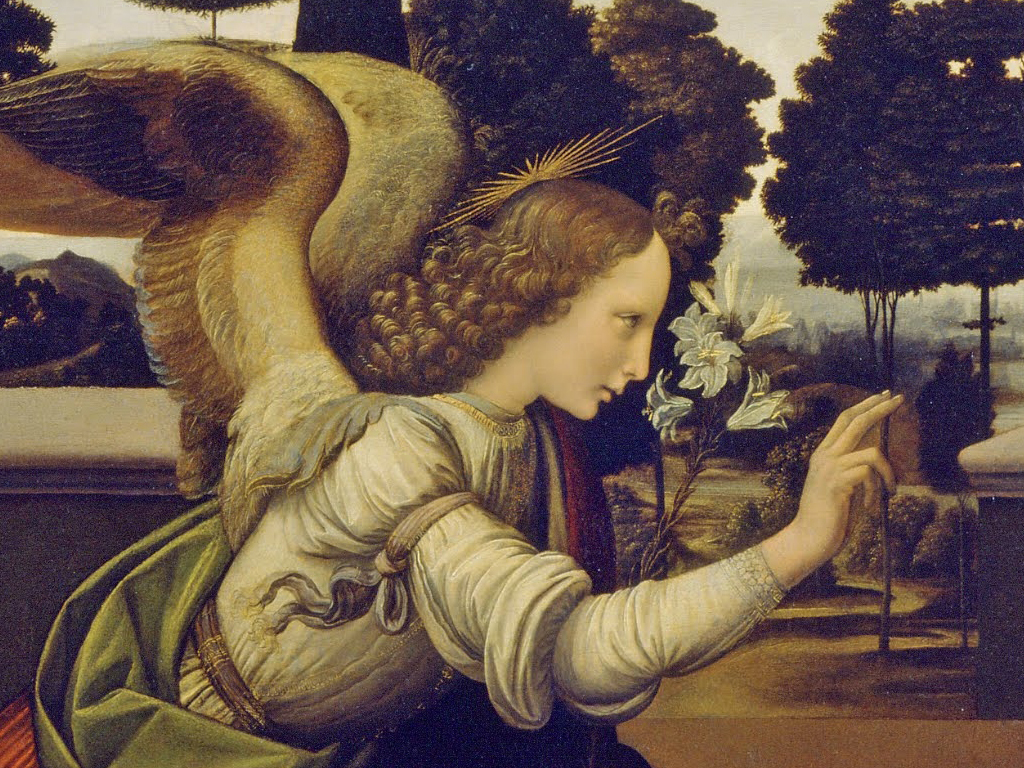Annunciation came early on in the career of Leonardo da Vinci, whilst he was in his early twenties and very much at the start of his artistic journey. This period was devoted to religious themes, with this example becoming amongst his most famous of all.
Da Vinci was still working under the influence of Andrea del Verrocchio at this stage, and it would take a number of years before the true personality of the artist would appear. We can track these changes over time, and The Annunciation provides an example of the starting point from which he begun, as in the early 1470s he was still employed as an apprentice within the studio of this Florentine master. It was from here that he learnt a great plethora of technical skills in a variety of disciplines, which laid the perfect foundation for what was to come.
The medium of tempera had dominated Italian art for centuries but the likes of Da Vinci would start to combine it with oils, and eventually later work exclusively in the latter for his paintings. We generally chose from a variety of wooden panels, on which to apply these mediums and in the case of The Annunciation he would make use of a panel of poplar. The wide format, almost panoramic, would rarely appear again in his oeuvre, giving this piece another aspect of uniqueness within his career.
The Annunciation became one of the most common religious themes within Italian Renaissance art, and Da Vinci was following in the footsteps of a number of other great names in choosing to tackle this topic. Indeed, even in its present location at the Uffizi Gallery in Florence, this is just one of several depictions of the Annunciation, though remains perhaps the most famous of all. One of the qualities of this work is how the artist combines content from religious scripture with precise portraits and a stunning landscape scene to produce a breaktaking piece that remains fresh all these centuries later.
Da Vinci developed a particular look for his portraits, and we see elements of that in Annunciation, with further refinements coming later on as he led up to iconic works such as the Mona Lisa. Within the piece in front of us here, we see brilliance, both in technique and innovation, but there are also mistakes which would be corrected in later works as the master practiced and refined his craft.
This article examines the large painting in depth, whilst also placing it within the context of the artist's overall career. We discuss the influences found within this piece, and also find clues as to how Da Vinci's style would develop over the coming decades. Annunciation remains his most respected contribution from his early years, and as he grew in confidence, so he would start to move further away from the influences that lie upon him whilst working as an apprentice.
Table of Contents
- Background
- Preparation
- Commission
- What is the Annunciation?
- Description
- Analysis
- Meaning
- Famous Paintings of the Annunciation
- Timeline
- Location
- Size and Medium
- Large Images of The Annunciation
- References
Background
Annunciation came very early on in Da Vinci's career, being one of the very first paintings attributed to his hand. Indeed, it literally contains some of his own fingerprints, such was the manner in which he would press paint into the wood. He was showing early signs of some of the innovative technqiues that would become hallmarks of his style, but these still needed time to evolve and so mistakes can be found within the painting as well. He was firmly a part of the studio of Verrocchio at this stage, and so trying to balance creativity with the teachings that he had undergone.
Indeed, many believe that this painting was something of a collaboration although most evidence points to Da Vinci playing much the biggest role in the completion of this work. Within the studio of Verrocchio he was introduced to a wealth of techniques and disciplines, perhaps generating a desire to make use of as many of these as possible. In Annunciation, the artist also had to consider how other artists had previously tackled this popular theme, but without merely mimicing their work.
Preparation
The discovery of a Da Vinci pen and ink drawing uncovered the artist's preparation for The Annunciation. It features a sleeve of the angel, and the angles remained much the same in the final painting. It was this study drawing that convinced many of the origins of the painting, when previously many had considered it to be the work of Domenico Ghirlandaio. This was very much the case throughout its time at the church of San Bartolomeo a Monteoliveto, and it was only upon its relocation to the Uffizi that it started to be considered as a Leonardo piece, which came in the late 19th century. One can assume too that this would have been one of many preparation sketches produced for the later painting, with the rest lost or damaged in the years that have passed since.
There also remains a sketch in the Louvre that some have claimed to be a preparation study for the Virgin's robes, but this connection seems less likely because of the differences that remain between the drawing and the later painting. Da Vinci would often sketch small individual elements and give them his full focus for just a few hours, and these have become hard for historians to then link to a later full composition, particularly because his drawings were rarely dated or documented by the artist himself. He would also sometimes practice his craft purely for that purpose, without a specific project in mind.
Commission
Sadly, it is not known as to who commissioned Annunciation (1472-1476) by Leonardo da Vinci. We also do not know where the painting was originally hung, prior to making its way to the church of San Bartolomeo a Monteoliveto, and then later the Uffizi Gallery in Florence, Italy.
What is the Annunciation?
The Annunciation refers to the passage Luke 1.26–38. The Annunciation would appear again in later guises, but this is the version that is most commonly referred to. The text below speaks of when the angel Gabriel informs Mary that she is to have a virgin birth, and from that become the mother of Jesus Christ, the son of God. This is clearly a key moment for followers of Christianity, and the texts have been visually represented in all manner of different ways by artists across the Renaissance.
"...And in the sixth month, the angel Gabriel was sent from God into a city of Galilee, called Nazareth,
To a virgin espoused to a man whose name was Joseph, of the house of David; and the virgin's name was Mary.
And the angel being come in, said unto her: Hail, full of grace, the Lord is with thee: blessed art thou among women.
Who having heard, was troubled at his saying, and thought with herself what manner of salutation this should be.
And the angel said to her: Fear not, Mary, for thou hast found grace with God.
Behold thou shalt conceive in thy womb, and shalt bring forth a son; and thou shalt call his name Jesus.
He shall be great, and shall be called the Son of the most High; and the Lord God shall give unto him the throne of David his father; and he shall reign in the house of Jacob for ever.
And of his kingdom there shall be no end.
And Mary said to the angel: How shall this be done, because I know not man?
And the angel answering, said to her: The Holy Ghost shall come upon thee, and the power of the most High shall overshadow thee. And therefore also the Holy which shall be born of thee shall be called the Son of God.
And behold thy cousin Elizabeth, she also hath conceived a son in her old age; and this is the sixth month with her that is called barren:
Because no word shall be impossible with God.
And Mary said: Behold the handmaid of the Lord; be it done to me according to thy word. And the angel departed from her..."
Description
Within Leonardo da Vinci's Annunciation we are set in a Nazareth garden, on the 25th of March. Archangel Gabriel appears on the left, with the Virgin sat across on the right hand side. This wide painting, constructed from five panels glued together, allows space between the two figures, and these areas are filled with delightful detail which provides symbolic meanings of their own. The Virgin is interrupted whilst reading the Bible, and the angel takes this opportunity to inform her that it is her destiny to carry and deliver Christ, Son of God. She humbly accepts this news, and in other interpretations holds her arms in a cross shape, that would symbolise her offer of service for this task.
Alongside the two figures in this detailed piece is a series of architectural touches behind the virgin, as well as elements of the garden itself, which sweeps off to the left. Additionally, a wide landscape then drifts off into the distance at the top of the painting, with a misty finish which adds depth as we look deeper into the work. The artist displays some of the hallmarks of what he was learning as an apprentice, and perhaps was enthused enough to include as much of it as he could within Annunciation. Some critics have pointed about technical issues with some of the content in this piece, but it must be remembered that the artist was young at this point, and some parts of the painting might have been completed by others, either at the time or in the centuries that followed.
Analysis
In terms of the symbolism in this painting, the lily held up by the angel represents the purity of the Virgin, who has been chosen for this important task. Da Vinci places the flower just around a gap in the garden wall, which helps is to attract our attention. The flowers found dotted around the garden are believed to represent Nazareth itself, as this was a term often connected to the location. The blue clothing helps us to identify the Virgin on the right hand side of the composition, and was a method used by artists for centuries when constructing religious scenes such as this.
The artist displays his artistic understanding, and lack of experience in equal measure within this painting. There is a wealth of architectural detail within this piece as well as a complex landscape scene across the background, offering a wealth of variety within the composition. When compared to his later work, though, we do see some elements that are not completed as quite as effectively, and there were also considerable number of amendments from the original underpainting, suggesting an artist that was not yet entirely sure about his approach in constructing a large image such as this.
Meaning
Whilst the main content in this painting simply refers directly to the passages of the Bible that cover The Annunciation, the artist did choose to add many smaller, more subtle elements which expand on some of these meanings across the painting. He is able to achieve this because of the two metre wide piece of wood on which this scene is painted, giving plenty of room for creative touches and innovations. One might compare this scene to some of the work of Sandro Botticelli, who embellished the likes of The Birth of Venus and Primavera with some delightful touches of detail, providing a feast for the eyes.
The Archangel holds the stalk of a lily in his left hand, with the flowers appearing just by his face. This symbolises purity. Some experts have argued that the flowers that are dotted around this garden scene more generally are also related to this meaning of purity on behalf of the Virgin, and perhaps the lily is just the most obvious symbol of that. The artist also provides an earth-like setting for this work, which may help viewers to connect with this important theme, and this was a technique which became popular within Italian art as a means to bringing faith to the people more effectively. The remaining elements, such as the lectern, were no so much items of symbolism, but more elements of influence from his apprenticeship under Verrocchio.
Famous Paintings of the Annunciation
Fra Angelico is perhaps the most famous for depicting The Annunciation, and he would re-visit this theme many times over. He passed away two decades before Da Vinci started working on the version in front of us here, and so potentially there may have been some influence, with Fra Angelico's San Marco version coming in 1440–1445. There would also be Annunciation of Cortona, Annunciation with Saint Peter Martyr and another version circa 1435, now in Madrid. Other great names from art history to have covered this theme include the likes of El Greco, Bartolome Esteban Murillo, as well as a number of lesser known painters from the same studio as Da Vinci.
Whilst Da Vinci would have been inspired by many aspects of these previous iterations, he would avoid replicating them too closely. For example, his interpretation placed both figures outdoors, which was unusual, and he also implemented far more detail into the scene than had been seen previously. This became a feast for the eyes, and even those of secular beliefs could still appreciate the aesthetic beauty of this masterpiece, even though some would deride it in the centuries that followed. Many who lauded this piece who appreciate how the painting could have worked even without the religious context, bears some similarities to the brilliance of Botticelli.
Timeline
Annunciation comes from the stages of Da Vinci's career, at which point all of his work was focused on religious themes. He was also very much still an apprentice at this point, and therefore encouraged to work in the style of his artistic master, Andrea del Verrocchio. Experts have since uncovered subtle additions by the artist which point to his later developments, both in terms of composition and also his techniques of brushwork, but the overall piece still loosely fits within the scope of the studio of Verrocchio.
There are few paintings attributed to Da Vinci that come before Annunciation. Madonna and Child with a Pomegranate and Tobias and the Angel are existing artworks dated prior to the piece, but both have highly disputed attributions. It may well have been that a young Leonardo was involved, perhaps even in a major way, but there is also likely to have been involvement from others alongside this budding artist. Certainly, all of the artist's other major works would arrive after Annunciation, in some cases even several decades later, with examples including Lady with an Ermine, The Virgin and Child with Saint Anne and Ginevra de' Benci.
Location
The artwork resides in the Uffizi in Florence, Italy, where it has resided since 1867. Its age, condition and historical significance has meant that it rarely leaves the gallery on loan, and so those wishing to view the original piece will likely need to travel to this famous gallery in person. According to the Uffizi, the item was originally hung in the church of San Bartolomeo a Monteoliveto, which lies just outside Porta San Frediano in Florence, Italy, and so would not have travelled far when being moved to its present location.
Size and Medium
Leonardo da Vinci painted Annunciation using oil and tempera onto a panel of poplar wood. The overall piece is 217 cm wide, and 98 cm long. It is loosely dated at having been completed between the years of 1472 to 1476, although the artist would have worked on a number of different projects during this period. The overall piece was constructed from five boards, which were glued together at the time, as it would have been very difficult for the artist to source such a large single piece of wood suitable for his work.
Whilst the panels have remained firmly attached to each other, there has been some necessary restoration work to areas of the painting itself. These have been completed in an adhoc fashion, and most alterations have never been documented. Certain sections have received multiple updates, whilst others have remained entirely untouched. The most recent amendments were made as recently as 2000, with this work highly researched and much more carefully and faithfully delivered.
Large Images of The Annunciation
See below for larger images of The Annunciation by Leonardo da Vinci. These should enable you to enjoy more of the detail in what is one of the artist's most famous paintings. Every time one looks at this painting, there seems to be new details to see that had not appeared previously, in what initially seems to be a fairly simple composition. The original is over two metres wide, which enabled such a level of precision to be added across a number of years as the piece was developed.
References
- Leonardo. The Complete Paintings and Drawings, Frank Zöllner & Johannes Nathan, Taschen
- Leonardo da Vinci, Walter Isaacson







